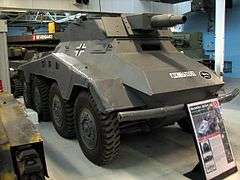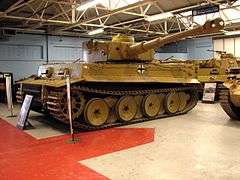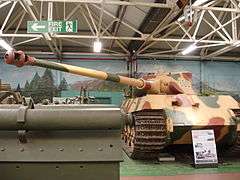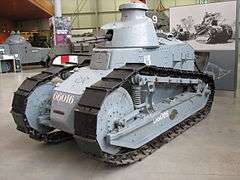The Tank Museum
 Museum logo | |
 Location of The Tank Museum within Dorset | |
| Established | 1947 |
|---|---|
| Location |
Bovington, Dorset England |
| Coordinates | 50°41′43″N 2°14′37″W / 50.695194°N 2.243611°W |
| Type | Military Museum |
| Public transit access | Wool railway station |
| Website | www.tankmuseum.org |
The Tank Museum (previously The Bovington Tank Museum) is a collection of armoured fighting vehicles at Bovington Camp in Dorset, South West England. It is about 1 mile (1.6 km) north of the village of Wool and 12 miles (19 km) west of the major port of Poole. The collection traces the history of the tank. With almost 300 vehicles on exhibition from 26 countries it is the largest collection of tanks and the third largest collection of armoured vehicles in the world.[Note 1] It includes Tiger 131, the only working example of a German Tiger I tank and a British First World War Mark I, the world's oldest surviving combat tank.
It is the museum of the Royal Tank Regiment, Royal Armoured Corps and a registered charity.[1] Bovington Camp, in which the museum is located, trains most sections of the British Army in tracked-vehicle driving as well as repairing and maintaining the vehicles in its workshops.
History

In 1916 the British War Office established the Bovington camp as a tank crew training facility. At that time the army was introducing tanks into the First World War in an attempt to break the stagnation of trench warfare. In 1919 the tanks returned to Bovington from France. Many of them were fit only for scrap. However, a small number of the least damaged vehicles were put to one side so that tank crews and designers could have an idea of the tank's early heritage.
In 1923 the writer Rudyard Kipling visited Bovington and recommended a museum should be set up. The collection grew greatly after the Second World War, as many Allied and captured Axis tanks were added. In 1947 it was opened to the general public. The Tank Museum has continued to expand and today it is primarily seen as a means of educating and entertaining the general public, with the exhibition being geared in this direction. Many of the tanks are in complete working order and can be seen in action throughout summer months in special displays.
The museum holds an annual TankFest display of their operating vehicles and visiting vehicles.
In 2012, the museum's historian David Fletcher, who had been an employee since 1982, was made an MBE "for his services to the history of armoured warfare".[2]
Exhibition halls

- World War I Hall (Tank Men)
Along with “The Trench Experience” this hall has recently been refurbished & renamed. As well as containing the majority of the museum's World War I tanks it now tells the story of men who crewed the first tanks between 1916 and 1918. The Lawrence of Arabia exhibition is no longer in the hall.
- Featured tanks: Mark I tank, IV, V, (one of the few World War I tanks still in working order), IX & Mark VIII "Liberty"tanks.
- Inter War Hall (War Horse to Horsepower)
Refurbished in 2014, this hall now explores the rise of the tank and the role of the cavalry in the mud of the Western Front.
- Featured tanks: Vickers A1E1 Independent, Peerless Armoured Car & Vickers Light tank, Mark II.
- World War II Hall
Is the biggest section, with tanks from most nations involved in the conflict.
- Amongst others it features: Panzer I, III, IV, Stug III, Tiger II, Jagdpanzer 38(t), Jagdpanther, Jagdtiger, SdKfz 251, Somua S35, Comet I, Matilda Mk I, A38 Valiant, Ram Cruiser Mk II, M24 Chaffee, M4 Sherman, M10 Tank Destroyer, M48 Patton, M26 Pershing, T17 Staghound, Hamilcar glider, DUKW, SU-76, T-26, KV-1, L3/33 LF, M13/40, Tortoise, Black Prince,
- Tamiya Hall

Sponsored by the scale-model manufacturer. This hall contains the Battlegroup Afghanistan exhibition. The men of the Royal Armoured Corps who have been involved in some of the fiercest fighting since World War Two. Hear first-hand accounts from soldiers who have fought there as well as exploring a recreated Forward Operating Base and a range of vehicles used in Afghanistan. The hall also contains a Conqueror, Chieftain (which is accessible as advertised), Challenger 1 and TOG2. The newly installed children’s soft play area is also located there.
- British Steel Hall (Tank Factory)
Explores the design & technology that goes into making tanks and AFVs. There is a mock production line of Centurions, (possibly Britain's best tank design) as well as prototype and experimental vehicles. Featured tanks a T-55 with sections cut out enabling visitors to see inside, Swedish S tank, prototype FV101 Scorpion and various Ferret armoured cars, along with the first M4 Sherman supplied to the British in World War II and an A13 Covenanter.
- The Tank Story Hall
This hall holds 35 of the most important tanks and AFVs in history, with a fascinating supporting collection housed in a vast state of the art multimedia exhibition. It follows the story of the tank, from its invention in 1915 through the 20th Century and into the future.
It features, amongst others, Little Willie, Whippet, FT17, Char B1, Panzer II, Tiger I (captured in Tunisia in April 1943 and fully restored to running condition by the workshops at Bovington, this is the only Tiger I left that is capable of running under its own power; it was used in the Brad Pitt film "Fury"), M3 Grant, T-34, Panther, DD tank Churchill Mk VII, Sherman Firefly, M48 Patton, T-72, T-62 and Challenger 2
The Vehicle Conservation Centre is a new building (opened in September 2013), added to provide cover for more of the collection and put on view vehicles that had previously not been seen by the public. It houses about 100 vehicles in 40,000 square feet, including a Charioteer, M41 Bulldog, M103, M60 Patton, T-54, Cold War and Iraqi T-55s, BMP-1, AMX-30, Type 69, Infanterikanonvagn 91, A33 Excelsior, T14 and SU-100.
Gallery
 British Alvis Saracen armoured car
British Alvis Saracen armoured car British Sabre light tank
British Sabre light tank German SdKfz 234 armoured car
German SdKfz 234 armoured car
 German Tiger II (with early-Porsche turret)
German Tiger II (with early-Porsche turret) American M103 heavy tank
American M103 heavy tank British Challenger 1 tank
British Challenger 1 tank Soviet SU-76M Self-propelled gun
Soviet SU-76M Self-propelled gun British TOG2 heavy tank prototype
British TOG2 heavy tank prototype Daimler Ferret in UN livery
Daimler Ferret in UN livery British A-9 Cruiser Mk I
British A-9 Cruiser Mk I Italian L3/33lf tankette flamethrower
Italian L3/33lf tankette flamethrower Sherman DD tank showing canvas flotation screen
Sherman DD tank showing canvas flotation screen French Renault FT tank
French Renault FT tank
 German Panther tank
German Panther tank
See also
- Tank museums
- Kubinka Tank Museum – Russia
- Musée des Blindés – France
- Military museum Lešany – Czech Republic
- Deutsches Panzermuseum – Germany
- Patton Museum of Cavalry and Armor – United States
- Yad La-Shiryon – Latrun – Israel
- Parola Tank Museum – Finland
- Other
- United States Army Ordnance Museum
- Polish Army Museum – large collection of Soviet, western and Polish AFVs
- Heartland Museum of Military Vehicles Nebraska, USA.
- Base Borden Military Museum Ontario, Canada
- Lists of armoured fighting vehicles
- Tank classification
Notes
- ↑ The Musée des Blindés in France has a collection of 880 armoured vehicles, although it includes fewer tanks than Bovington.
References
- ↑ Charity Commission. The Tank Museum Limited, registered charity no. 1102661.
- ↑ "David Fletcher Honoured". The Tank Museum. Retrieved 20 August 2014.
External links
| Wikimedia Commons has media related to The Tank Museum. |
- Tank Museum website
- Tiger Tank restoration website
- Rio de Janeiro's military vehicle modeling association – photographs inside the museum

